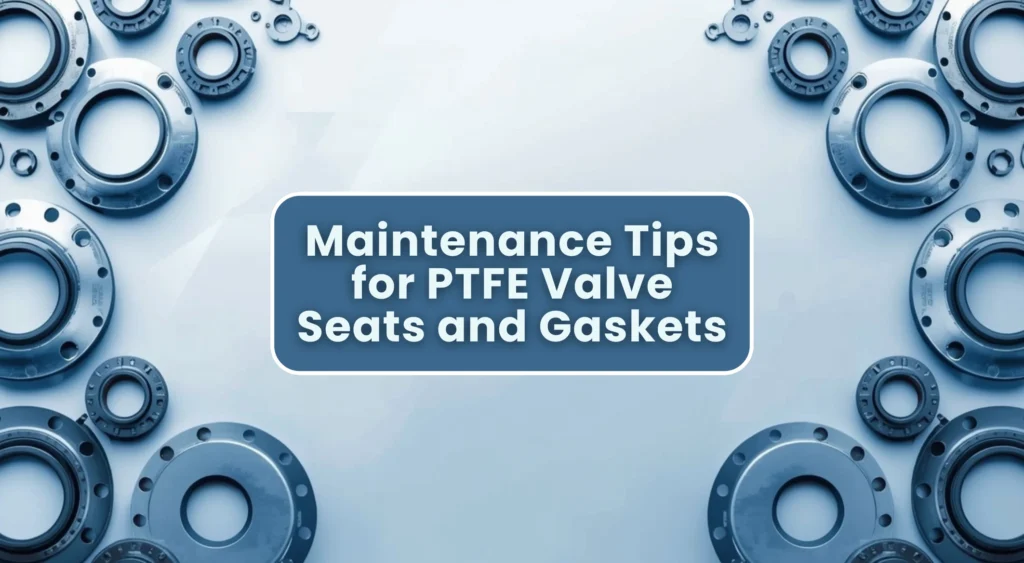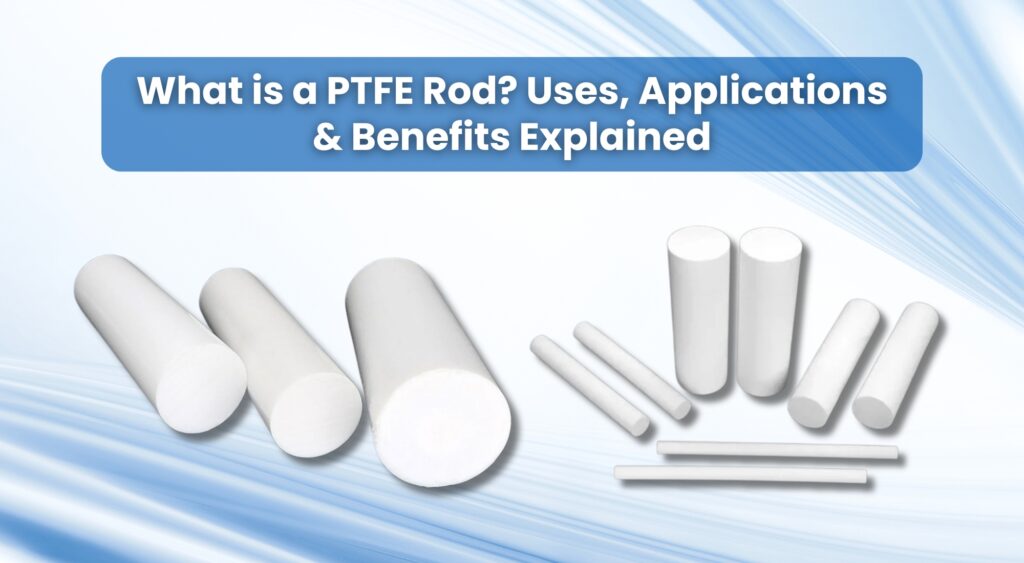Safety against leaks is usually ensured by keeping machines safe. The industries that need this substance can be many. For these industries, PTFE is considered an inert material. It is highly functional at variable temperatures and hence serves excellently well as a sealing material. However, it is necessary to maintain PTFE valve seats and gaskets.
Otherwise, leaks may develop and cause trouble for the smooth functioning of the machines. Neglect of maintenance leads to wastage of energy and loss of efficiency. Their operational conditions may also become highly hazardous to human life. Proper maintenance of PTFE parts will increase the life span of their functionality.
In this blog, we present delicately simple maintenance tips for PTFE Gasket valve seats and gaskets and discuss many issues concerning cleaning, inspection, safe handling, storage, damage prevention, and more. By abiding by these mainstay guidelines, you will more often than not avoid all inconvenient occurrences and keep your machinery vibrant for a reasonably extended period.
Importance of Maintaining PTFE Valve Seats & Gaskets
Here are some easy maintenance tips for PTFE valve seats and gaskets. Following them will help keep the parts maintained for a longer period.
Keep PTFE Valve Seats and Gaskets Clean
Keeping PTFE valve seats and gaskets clean is key to their proper function. This could be any form of dirt, grease, or foreign material. Such materials tend to cause leaks and speed up the wear of the surface. A surface devoid of such materials will form a strong seal and enable smooth operation. A clean surface will also allow for easier inspection and concealment of any damage.
- The object requires rinsing to remove dust and all tiny particles.
- Soap residue needs to disappear completely because it requires total removal through rinsing.
- You should dry the object either with a soft cloth or by letting the parts dry on their own.
- Ensure that the parts are cleaned before reinstalling them in the device.
Use Safe Cleaning Materials to Protect PTFE Components
To keep PTFE valve seats and gaskets in good shape, use a gentle touch and the right cleaners. The use of strong cleaners may lead to surface damage and may reduce the ability of the part to seal. Using safe cleaners and soft tools keeps PTFE parts smooth and strong. Use the mildest option. It should not scratch or weaken the parts.
- Wipe using a cloth that is gentle or a sponge.
- Keep clear of coarse pads or metal scrubbers.
- For stronger action, use mild cleaners designed for delicate materials.
- Do not use metal scrubbers or any rough pads.
Regular Inspection for Wear and Damage
Check PTFE valve seats and gaskets often for small issues. This helps prevent bigger problems in the future. Leaks and damages can be a consequence of even small cracks, scrapes, or bends. You can avoid and fix damage like this with regular checks on the components. This will help in removing the need for a very expensive emergency fix in the future.
- Search for any fractures, incisions, or other types of surface damage.
- Verify if the valve seat or the gasket has become deformed.
- Look for thinning, flattening, or other signs of wear.
- Do not attempt to fix severely worn parts; replace them immediately.
- Inspect after cleaning and before reinstallation.
Avoid Excessive Heat and Pressure
PTFE valve seats and gaskets are very versatile. Excessive temperature may damage the material, and excessive pressure is also harmful. Pressure greater than the rated gaskets leads to cracking and leaks. Keeping these parts in safe conditions helps them last longer and work well.
- Check the temperature and pressure settings that are safe to use. You can find the safe range in the equipment manual.
- Equipment should not run hotter than the preset heat limit.
- Changes in temperature or pressure should be incrementally small.
- To continuously remain within safe operating levels, the operating conditions must be monitored regularly.
- Replace PTFE components that appear warped or have pressure-related damage.
Handle PTFE Components Gently
Though PTFE valve seats and gaskets are robust in functionality, they do require a gentle touch during handling. The material life and sealing efficacy can be compromised due to rough handling, bending, or scratching while cleaning or installation. You help in the longevity of the parts and their effectiveness by being gentle.
- Remove the PTFE pieces through separate steps while maintaining exactness during each movement.
- The gasket and valve seat must stay in their original positions without any movement.
- Use a pair of clean gloves to keep oil and dirt away from the materials.
- The parts should rest on a flat, clean surface when they are not in use.
Lubrication Tips for PTFE Valve Seats & Gaskets
Certain gaskets and PTFE valve seats need a safe lubricant for optimal performance. The application of lubricant to components helps reduce friction, which makes sealing operations easier while protecting components from excessive wear. The wrong lubricant application will create damage to PTFE materials. The lubricant needs to prove safety for PTFE implementation.
- Apply lubricants that the manufacturer of your equipment recommends.
- Avoid using oils or greases that have the potential to interact with PTFE.
- The application of lubricant requires spreading a thin layer across the surface that needs lubrication.
- Avoid excessive lubrication. The accumulation of dirt and dust occurs because of this process.
- Perform regular seal checks to confirm that the lubricant remains effective and safe.
Proper Storage of Spare PTFE Parts
If not stored correctly, PTFE valve seats and gaskets can sustain various types of damage. For example, bending, sunlight, and heat can lower material quality before use. Store spare parts in safe, designated spots. This ensures they perform well when needed.
- Store PTFE components in environments that maintain cleanliness and dryness and cool temperatures.
- The products should stay in their original form by placing them on flat surfaces without any attempts to bend or fold them.
- Protect the plants against direct sunlight exposure and all heat sources.
- Store the items in boxes or sealed bags to stop dust from accumulating on them.
- Create a clear identification system for all spare parts because this will help you prevent future confusion between parts.
Maintain a PTFE Maintenance Log
The process of record keeping for cleaning and inspection activities enables users to monitor their progress with no difficulties. Your logs contain a history that shows every check, cleaning, and part replacement activity. The system helps prevent oversight by supporting the correct maintenance of PTFE valve seats and gaskets.
- Write down the date when you perform every cleaning and inspection.
- Note if you performed cleaning, lubrication, or part replacement.
- During the inspection, you need to record every damage that becomes apparent.
- Keep a notebook or chart to record all information.
- The chart requires regular examination to establish maintenance schedules for the upcoming period.
Follow Manufacturer Guidelines Strictly
The installation process of PTFE valve seats and gaskets requires specific procedures that you need to follow. The part will experience performance problems when these instructions are ignored, which will also shorten its operational time. Following the guidelines results in secure operations that produce trustworthy results.
- Read through the product manual before you start installing.
- Run the equipment at specified temperature ranges together with pressure limits.
- Follow the suggested cleaning and lubrication procedures.
- Replacement parts need to follow the exact specifications of the original equipment.
- Seek the manufacturer’s advice if maintenance or usage is unclear.
Replace Worn or Damaged Parts on Time
In the long run, all PTFE valve seats and gaskets will wear out. The failure to maintain worn components leads to leaks and energy waste, and a complete machine breakdown. The machine operates smoothly by replacing worn parts on time, which prevents expensive repair costs.
- During the inspection process, you need to search for any signs of damage, which include flattening and cracks, visible wear, and other indications of damage.
- Replace the parts immediately if there is any damage.
- Keep a supply of PTFE valve seats and gaskets on hand, so you can replace them immediately.
- For best performance, use authentic parts that are of good quality.
- Note the replacement date in your maintenance record.
Conclusion
The PTFE valve seats and gaskets require simple maintenance but are essential. Leaks must be prevented, machinery must be protected; therefore, maintenance guides for PTFE valve seats and gaskets must be thoroughly followed. This maintenance procedure will result in an increased lifespan. Being harsh will cause problems with the machinery. If lubrication is to be applied, then it should be applied safely. Proper storage must be ensured with timely inspections. Cleaning from time to time will never come amiss. The more one follows the manufacturer’s instructions, the better. After all, the wear and tear parts must be changed immediately.
A logbook will help remind you about the maintenance activities. It will also help in planning future inspections. Each and every little effort will count. Small things like using gentle cleaning tools and laying parts flat can really make a difference. This, in turn, improves the performance and safety of the system; anyone could maintain PTFE valve seats and gaskets by following these simple steps. This saves time and money and makes it possible for the machines to run smoothly. Proper maintenance will lead to reliable and extended operation.
Ensure your machinery runs smoothly and leak-free. For high-quality PTFE valve seats, gaskets, and expert maintenance advice in India, contact Hindustan Polymer today!
Frequently Asked Questions
Can PTFE components withstand elevated temperature and pressure?
PTFE components can withstand their temperature and pressure ranges effectively, but to prevent damage to the parts, the specified limits must be followed.
What advantages do these tips offer?
If the parts are adequately maintained, then leaks are averted, smooth operations are strived for, and the overall life of the parts is prolonged. This ultimately leads to time-saving and cost-saving in terms of big repairs.
Do PTFE gaskets and valve seats require lubrication every time?
No. Using a compatible and safe lubricant is permissible only if the equipment manufacturer suggests it. Greases or oils that can damage PTFE should never be used.
How do I check if I am using the appropriate valve seat or PTFE gasket?
Look up the equipment manual or the manufacturer’s documentation. Performance issues may arise, as well as leaks, if the correct type or size is not used.



